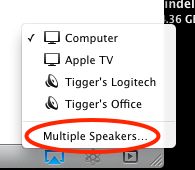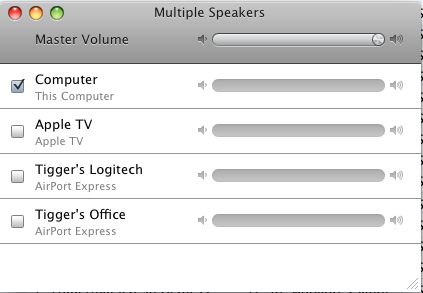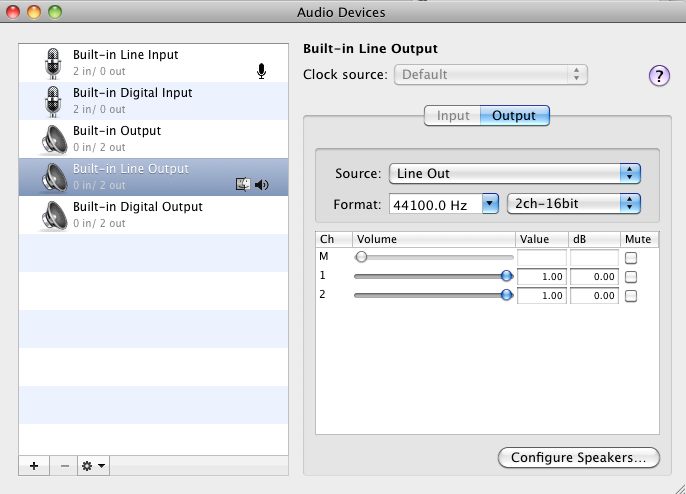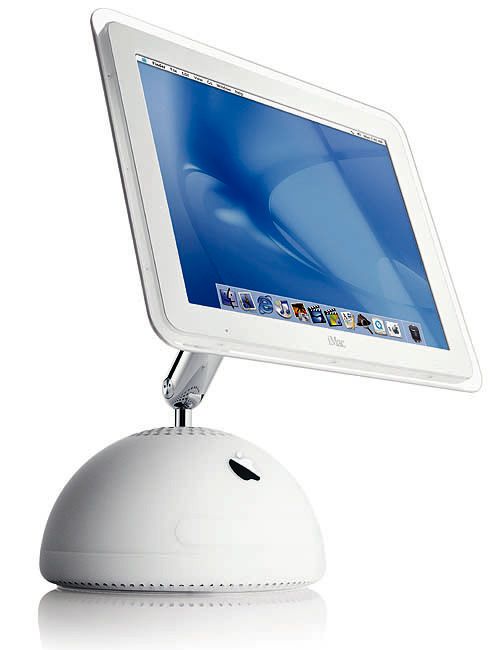Full house sound, wirelessly.
This piece gets a bit technical so hold on to your hat; however, it may be helpful for those experimenting with AirPlay routed to multiple speakers simultaneously.
Following up on yesterday’s column on using AirPlay with TuneIn radio on an iDevice, I rooted around and found another set of Logitech powered speakers languishing in the place the black beetles call home in the garage. These are the estimable Logitech Z4i with a powered bass and two satellites, making for excellent sound. Back when I used an iMac G5 and later the ill fated 24″ iMac which fried its GPU thanks to Apple’s crappy design, the satellites velcro’d nicely to the sides of the iMac’s monitor with the bass out of sight under the workspace. I had put them away in favor of smaller desktop speakers when I built the HackPro and had quite forgotten about them.
Well, as the shared Brother printer in the office is attached to an Airport Express (AEX) as a Bonjour printer, naturally I could not leave well enough alone, realizing that I could connect these powered Logitech speakers to the AEX for yet another sound output from any iDevice. A few moments of plugging things in and TuneIn Radio sound on my iPad was coming from these Logitechs.
Now how about full house sound? Well, I can’t see any place where AirPlay on an iDevice permits selection of multiple speakers, though I would bet dollars to doughnuts that this is only a matter of time. Maybe the iPad needs to be upgraded to the multi-core ARM A9 CPU before this becomes possible. However, firing up iTunes on the HackPro, where my extensive music library resides, I clicked on the AirPlay logo and this is what I saw:

AirPlay on iTunes and the HackPro.
Clicking on ‘Multiple Speakers’ I got this selection panel:

The multiple output panel in iTunes.
I checked off all the speakers and adjusted the volume but …. the sound keeps cutting out. Selecting just the HackPro’s speakers (“Computer”) all is fine, but select any other destination alone or in addition and the sound cuts out.
Going to Utilities->Audio MIDI Setup I adjusted the output settings to the least demanding, thus (2ch-24bit is the default):

Audio MIDI settings.
This reduced the cutting out but did not eliminate it, so I’m guessing there’s some glitch either in my wifi system (the HackPro where iTunes runs uses 2.4gHz 802-11n wifi as I cannot use pure 802-11n at 5gHz as I need the 802-11g mode for compatibility with my iPhone, and do not own the latest dual band Airport Extreme). All my sound files are in uncompressed format, meaning they are large, for maximum quality. MP3 is a poor, over-compressed format for sound fidelity. The file size doubtless is not helping matters.
For further diagnosis I went to the MacBook Air which uses 802-11n wireless, started iTunes and tried playing a track stored locally in iTunes on the MBA. Perfect. I could enable all remote speakers and all played fine with individual volume control available for each, suggesting that the lower speed of the 2.4gHz 802-11n on the HackPro may be a limiting factor. There are a lot of variables here so it could well be something else, but I expect I’ll get there through a process of elimination.
Getting ambitious, I next loaded the remote library on the MacBook Air from the HackPro, where iTunes->Advanced->Turn On Home Sharing is set to ‘On’. Well, the stuttering, while greatly reduced, was still there so clearly there is a bandwidth or speed issue with the HackPro which looks like it needs 802-11n. Meanwhile, I’ll just move my favorite tunes from the iTunes library on the HackPro to the one on the MacBook Air for those occasions when whole house sound is called for.
An encouraging experiment.
Update: A solution to the stuttering problem:
I put on the old thinking cap and took the resident Border Terrier for a walk. Always clears the mind, I find. I had never paid any attention to the sound technology in the HackPro where my iTunes library resides. All I need it to do is drive pokey desktop speakers for the usual mail sounds, etc. I do not listen to music through its speakers. Its 802.11g should be more than adequate for routing sound files, even if uncompressed. So could it be the Digital to Analog Converter in the HackPro that was choking? Well, I fired up that ancient old iMac with the 1.25 gHz IBM G4 CPU and a scant 1 gB of RAM which we have owned some ten years now. It’s mostly used for web surfing and is by far the most reliable Mac I have ever owned.
I reckoned that I would simply update iTunes on the iMac (which runs Leopard, the last version of OS X supported on the G3/4/5 CPUs) and then point iTunes to the library of music on the HackPro. While the iMac uses 802-11n it would still be no faster than 802-11g as the slowest component in the equation is the HackPro and it’s 802-11g. But, and here’s the key, I would be using the iMac’s DAC to convert the digital stream to analog sound and my bet was that even the ancient DAC in the iMac would be pretty good, given Apple’s focus on sound reproduction.
And this proved to be the case! I told the iMac to send sound to three speaker sets (Apple TV, Office and Dining Room) and it is playing perfectly for the past hour. If it does start to stutter, I’ll simply move the library of music to its internal hard drive, taking the HackPro’s poky wifi out of the equation, but so far it’s working fine. I suppose I could also place the iTunes files on an external hard drive connected to the iMac but Apple has said that it does not support external HDDs for use with AirPlay, so I’m not pushing that angle. It may work. It may not. What is tremendous is that not only does this ancient hardware support AirPlay with the latest iTunes download (congratulations, Apple!) but sports a decent DAC which is better than the PC-grade one in the HackPro.
This analysis seems to make sense. The old iMac is receiving a digital file and locally converting it to analog. The original approach had the HackPro sending out an analog file to the speakers and, I’m guessing, that’s larger than the pre-DAC-processed digital file. The speakers attached to the HackPro worked fine with no stuttering as they are hard wired, whereas the remote ones stuttered owing to their use of wifi for reception. So it’s either a slow DAC in the HackPro or the lack of 802-11n in that machine.
Another alternative is to retrofit the HackPro with a better DAC but, frankly, I can’t be bothered and so far my total investment in this project is one AEX for $88. That’s enough!
Bottom line? If you have an old G3/4/5 Mac in the home, consider making it a music server for use with AirPlay.

Meet my new old music server.
Second update:
After two hours of music play I would still get the occasional stutter. So I moved my iTunes library to the internal drive of the G4 iMac and loaded the library from there. After two further hours of listening there was no more stuttering.
I’m surprised to read “Apple has said that it does not support external HDDs for use with AirPlay”. If you create a symbolic link from your iTunes library to an external HD, how could iTunes know where the files come form?